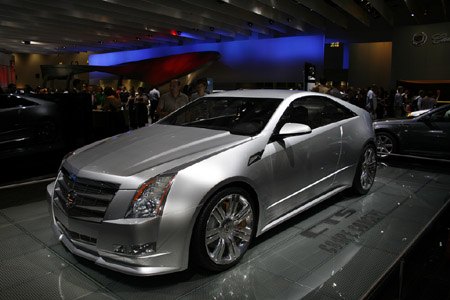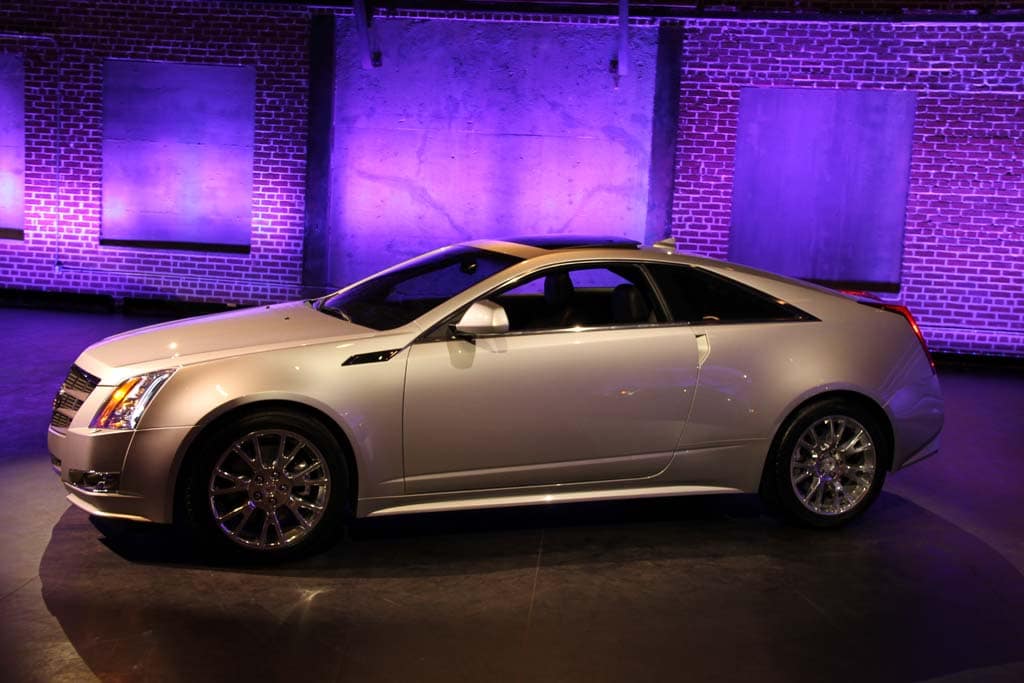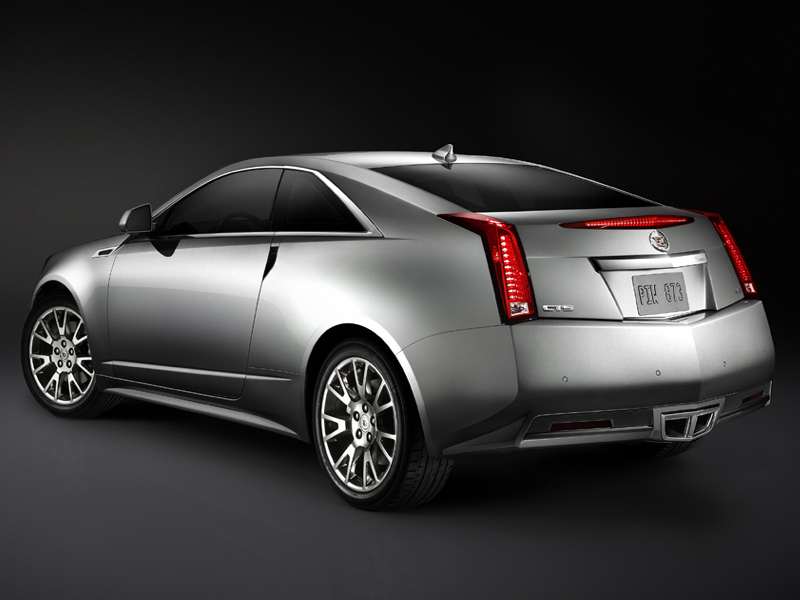The first generation CTS-V is based on the same rear-wheel-drive GM Sigma platform as is the base model CTS. The use of a V8 engine required a unique engine cradle distinct from the base CTS V6. Larger anti-roll bars and larger shocks were also added. The spring rate was significantly increased. The 2006-2007 update also included a stronger rear differential and half shaft design. Unique front and rear treatments also included mesh grilles over the front openings, a track-ready suspension, and 18x8.5 inch wheels inside of P245/45R18 Z-rated Goodyear Eagle F1 Supercar run-flat tires. Brakes were 13.97-inch (355 mm) rotors in the front, with 14.37-inch (365 mm) rotors in the rear - each with four piston Brembo calipers on the front and rear wheels. In addition, GM badges were added on 2006 models.

So you can see that Cadillac

cadillac cts coupe concept 1
The CTS sedan is enhanced with GM performance parts like a GM LS engine V8 from the C5-generation Chevrolet Corvette Z06, as well as the Corvette Z06's six-speed Tremec manual transmission. From 2004 and 2005, the CTS-V came with the 5.7 liter pushrod OHV LS6 engine producing 400 hp (298 kW) at 6,000 rpm and 395 lb·ft (536 N·m) of torque at 4,800 rpm. The 5 ft lb torque reduction of the CTS-V vs the LS6 used in the C5 Z06, was due to the exhaust manifold that needed to be used on the CTS-V. From 2006-2007, the previous LS6 engine was superseded by the new 6.0 liter OHV LS2 engine as used in the base 2006 Chevrolet Corvette. The new LS2 engine was rated at the same 400 hp (298 kW) at 6,000 rpm with the peak torque of 395 lb·ft (536 N·m) at 4,400 rpm. While both engines offer the same HP and torque specifications, the LS2's benefit was a wider torque band, due to the higher displacement it offered.

CTS-V Coupe.jpg
The only available transmission was the six-speed manual Tremec T56. The transmission used the skip-shift feature to conserve fuel during light loads by preventing drivers from using the second and third gears, and a dual mass flywheel to reduce "rattle" in no load conditions. The rear axle was a Getrag limited slip IRS unit with a 3.73:1 ratio.

Pricing on the Cadillac CTS
The second generation CTS-V is based on the new GM Sigma II platform. The rear-wheel-drive platform is the basis for the 2008 to present Cadillac CTS base model with which the CTS-V shares most of the body work. The suspension features coil springs front and rear. The front suspension is a Control arm arrangement while the rear is an independent Multi-link suspension. To improve the handling and comfort, the 2009 CTS-V uses BWI Group's MagneRide technology. The dampers, filled with magnetorheological fluid, are adjusted based on sensor readings that happen at 1ms intervals. The sedan has four wheel disc brakes similar to the first generation. The front brakes were increased in size to 14.96-inch (380 mm) ventilated discs with six piston Brembo fixed calipers. The rear brakes are 14.68-inch (373 mm) ventilated rotors with four piston calipers. Steering is speed-sensing hydraulic-assist rack-and-pinion. The steering ratio is 16.1:1. Tire sizes are 255/40ZR19 front and 285/35ZR19 rear on 19x9.0 inch and 19x9.5 inch wheels front and rear.

Expect the V-series coupe to

2011 Cadillac CTS Coupe Front
The powerplant in the 2009 CTS-V is a supercharged OHV 6.2 liter LSA V-8, based on the LS9 V-8 from the recently released Chevrolet Corvette C6 ZR1. It produces 556 hp (415 kW) and 551 lb·ft (747 N·m) of torque. The choice to use an Overhead valve (OHV)) arrangement (also known as a pushrod engine) is unique in the luxury performance sedan market where competitors typically use dual overhead camshaft (DOHC) engines. The engine is produced in GM's Silao, Mexico engine assembly plant. The LSA engine has a bore and stroke of 4.06 x 3.62 inches (103.25 x 92.0 mm). The engine block is cast aluminum 319-T5 alloy with cast-iron cylinder liners. The crankshaft is forged steel using powdered-metal connecting rods. Pistons are high-silicon Hypereutectic Aluminum alloy replacing the forged aluminum used in the LS9 engine. The compression ratio is 9.1:1. The cylinder heads are based on the Corvette's LS3 head and are cast from type 356-T6 Aluminum alloy. The exhaust manifolds are cast iron. The supercharger is a twin four-lobe Roots-type unit displacing 1.9 liters. It is Eaton's Twin Vortices Series (TVS) generating a maximum boost of 9.0 psi (0.6 bar). Intake air is cooled with a water-to-air intercooler built directly into the supercharger unit. The LSA uses iridium-core spark plugs.

cadillac-cts-coupe12

2011 Cadillac CTS Coupe

2011 CADILLAC CTS COUPE
There are manual and automatic transmission choices. The manual is a Tremec TR-6060 six speed transmission with a short-throw shifter, twin disk clutch and dual-mass flywheel. The 6L90 automatic is a paddle shift conventional (planetary gearing and torque converter-based) automatic six speed.

The 2011 Cadillac CTS Coupe

Cadillac CTS Coupé 2011
Production of the CTS-V sedan began in the summer of 2008 in the Lansing, Michigan GM plant. Total Production of the CTS-V for the 2009 model year was approximately 3,500 out of approximately 59,716 CTS model production. The 2009 CTS-V has a base price of US$59,995, and was available for purchase as of November 1, 2008.

saw a CTS Coupe V-series

2011 Cadillac CTS-V Coupe

Cadillac CTC-V (CTS-V Coupe)

CADILLAC CTS-V SPORT WAGON

2008-cadillac-cts-coupe-

So you can see that Cadillac

cadillac cts coupe concept 1
The CTS sedan is enhanced with GM performance parts like a GM LS engine V8 from the C5-generation Chevrolet Corvette Z06, as well as the Corvette Z06's six-speed Tremec manual transmission. From 2004 and 2005, the CTS-V came with the 5.7 liter pushrod OHV LS6 engine producing 400 hp (298 kW) at 6,000 rpm and 395 lb·ft (536 N·m) of torque at 4,800 rpm. The 5 ft lb torque reduction of the CTS-V vs the LS6 used in the C5 Z06, was due to the exhaust manifold that needed to be used on the CTS-V. From 2006-2007, the previous LS6 engine was superseded by the new 6.0 liter OHV LS2 engine as used in the base 2006 Chevrolet Corvette. The new LS2 engine was rated at the same 400 hp (298 kW) at 6,000 rpm with the peak torque of 395 lb·ft (536 N·m) at 4,400 rpm. While both engines offer the same HP and torque specifications, the LS2's benefit was a wider torque band, due to the higher displacement it offered.

CTS-V Coupe.jpg
The only available transmission was the six-speed manual Tremec T56. The transmission used the skip-shift feature to conserve fuel during light loads by preventing drivers from using the second and third gears, and a dual mass flywheel to reduce "rattle" in no load conditions. The rear axle was a Getrag limited slip IRS unit with a 3.73:1 ratio.

Pricing on the Cadillac CTS
The second generation CTS-V is based on the new GM Sigma II platform. The rear-wheel-drive platform is the basis for the 2008 to present Cadillac CTS base model with which the CTS-V shares most of the body work. The suspension features coil springs front and rear. The front suspension is a Control arm arrangement while the rear is an independent Multi-link suspension. To improve the handling and comfort, the 2009 CTS-V uses BWI Group's MagneRide technology. The dampers, filled with magnetorheological fluid, are adjusted based on sensor readings that happen at 1ms intervals. The sedan has four wheel disc brakes similar to the first generation. The front brakes were increased in size to 14.96-inch (380 mm) ventilated discs with six piston Brembo fixed calipers. The rear brakes are 14.68-inch (373 mm) ventilated rotors with four piston calipers. Steering is speed-sensing hydraulic-assist rack-and-pinion. The steering ratio is 16.1:1. Tire sizes are 255/40ZR19 front and 285/35ZR19 rear on 19x9.0 inch and 19x9.5 inch wheels front and rear.

Expect the V-series coupe to

2011 Cadillac CTS Coupe Front
The powerplant in the 2009 CTS-V is a supercharged OHV 6.2 liter LSA V-8, based on the LS9 V-8 from the recently released Chevrolet Corvette C6 ZR1. It produces 556 hp (415 kW) and 551 lb·ft (747 N·m) of torque. The choice to use an Overhead valve (OHV)) arrangement (also known as a pushrod engine) is unique in the luxury performance sedan market where competitors typically use dual overhead camshaft (DOHC) engines. The engine is produced in GM's Silao, Mexico engine assembly plant. The LSA engine has a bore and stroke of 4.06 x 3.62 inches (103.25 x 92.0 mm). The engine block is cast aluminum 319-T5 alloy with cast-iron cylinder liners. The crankshaft is forged steel using powdered-metal connecting rods. Pistons are high-silicon Hypereutectic Aluminum alloy replacing the forged aluminum used in the LS9 engine. The compression ratio is 9.1:1. The cylinder heads are based on the Corvette's LS3 head and are cast from type 356-T6 Aluminum alloy. The exhaust manifolds are cast iron. The supercharger is a twin four-lobe Roots-type unit displacing 1.9 liters. It is Eaton's Twin Vortices Series (TVS) generating a maximum boost of 9.0 psi (0.6 bar). Intake air is cooled with a water-to-air intercooler built directly into the supercharger unit. The LSA uses iridium-core spark plugs.

cadillac-cts-coupe12

2011 Cadillac CTS Coupe

2011 CADILLAC CTS COUPE
There are manual and automatic transmission choices. The manual is a Tremec TR-6060 six speed transmission with a short-throw shifter, twin disk clutch and dual-mass flywheel. The 6L90 automatic is a paddle shift conventional (planetary gearing and torque converter-based) automatic six speed.

The 2011 Cadillac CTS Coupe

Cadillac CTS Coupé 2011
Production of the CTS-V sedan began in the summer of 2008 in the Lansing, Michigan GM plant. Total Production of the CTS-V for the 2009 model year was approximately 3,500 out of approximately 59,716 CTS model production. The 2009 CTS-V has a base price of US$59,995, and was available for purchase as of November 1, 2008.

saw a CTS Coupe V-series

2011 Cadillac CTS-V Coupe

Cadillac CTC-V (CTS-V Coupe)

CADILLAC CTS-V SPORT WAGON

2008-cadillac-cts-coupe-












No comments:
Post a Comment